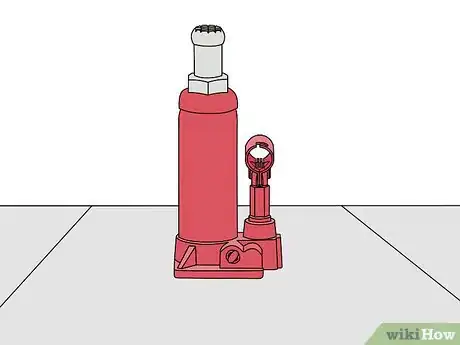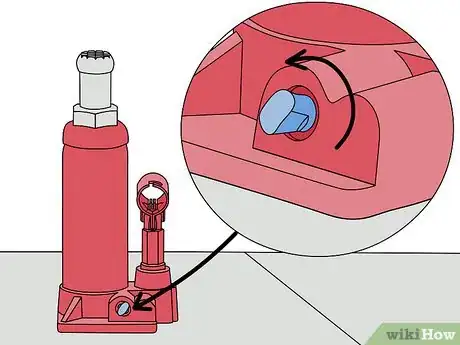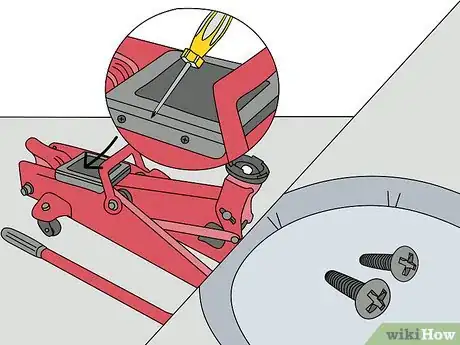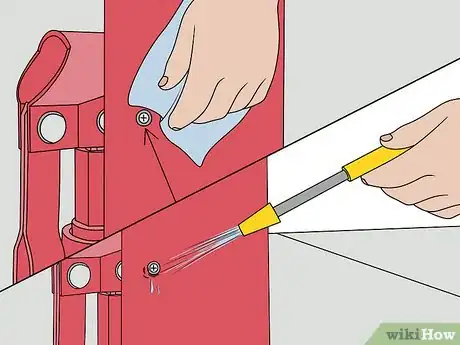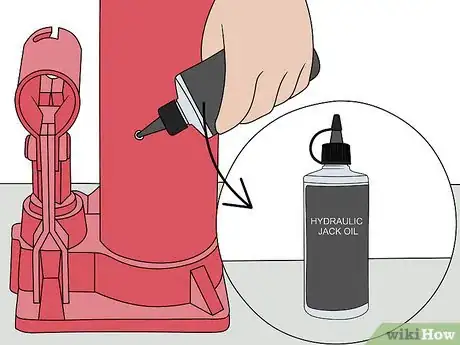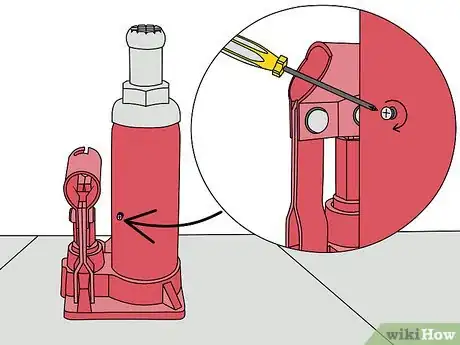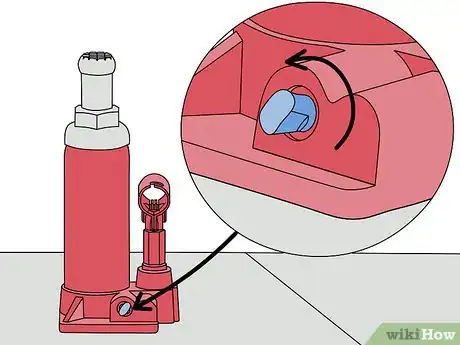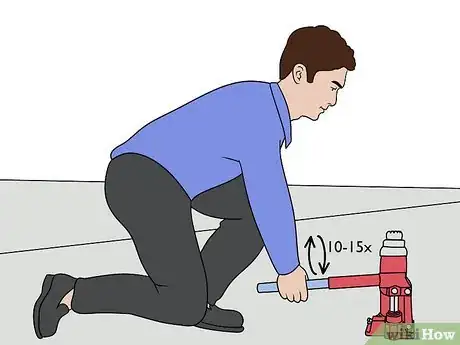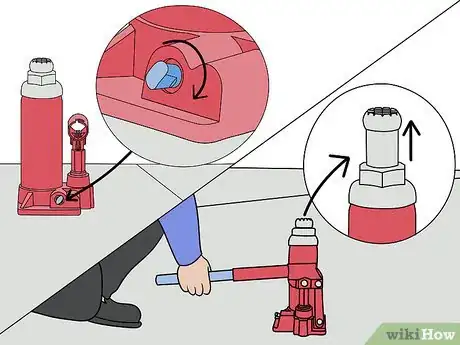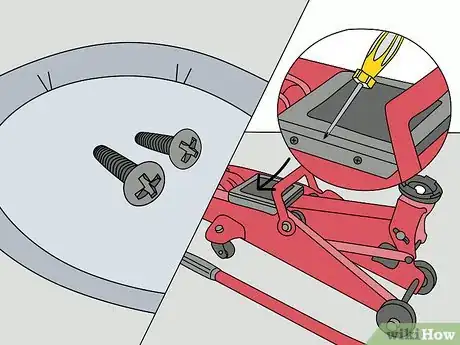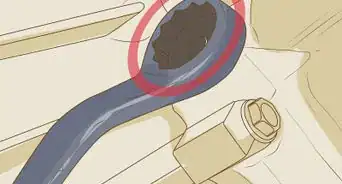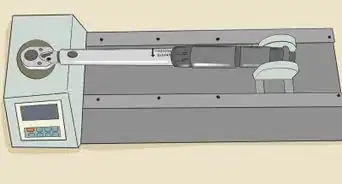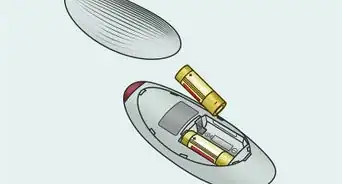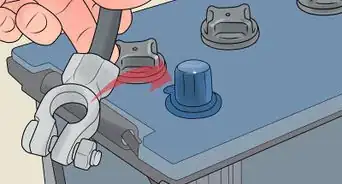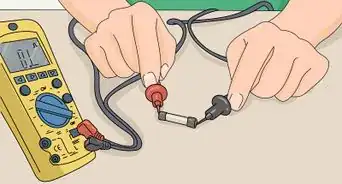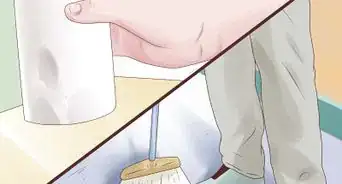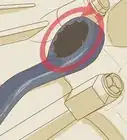This article was co-authored by wikiHow Staff. Our trained team of editors and researchers validate articles for accuracy and comprehensiveness. wikiHow's Content Management Team carefully monitors the work from our editorial staff to ensure that each article is backed by trusted research and meets our high quality standards.
wikiHow marks an article as reader-approved once it receives enough positive feedback. In this case, 90% of readers who voted found the article helpful, earning it our reader-approved status.
This article has been viewed 475,074 times.
Learn more...
A hydraulic jack is a device used to lift heavy objects, usually cars or trucks. The system works by using oil to grease the internal mechanism. If you’ve just bought a new jack, it won’t have any oil in it and you’ll have to fill it. Jacks also require oil refills every few years. First, remove the cover plate and filler plug. Then fill the chamber with hydraulic jack oil. Finally, follow the procedure to bleed excess air in the system, and your jack should be in good working order.
Steps
Filling the Jack with Oil
-
1Position the jack on flat, level ground. This prevents the jack from rolling while you work on it. It also keeps the oil level so you can fill the chamber accurately.
- Also place the jack somewhere that can get dirty, just in case you spill some oil. If you don't want oil in your driveway, try doing this in the street.
-
2Open the release valve. This lowers the jack so you can access the filler plug. Different jacks may have different release mechanisms. On some jacks, turning the handle counterclockwise lowers the press. On others, you have to press a release valve in a different spot.[1]
- If you’re unsure how your jack releases, consult your owner’s manual.
- Keep the release valve open while you work.
Advertisement -
3Remove the cover plate if your jack has one. Depending on your jack model, there may be a cover plate that protects the jack’s internal mechanism. Remove any screws holding this cover in place. Then lift the cover off.
- Depending on the type of jack you have, the cover plate might come off entirely or just lift up. If the plate comes off, keep it in a safe place so you don’t lose it.
- Usually these screws require a Phillips head screwdriver, but check your particular model to see what type of screwdriver you need.
- Don’t lose the screws you remove. Keep them in a safe place so you can put the cover back on later.
-
4Wipe the area around the filler port plug. The filler port is where you will pour the oil. To prevent contamination, use a rag and clean off the area around the filler plug. This keeps dirt out of the oil reservoir.[2]
- If your jack is old and there is a lot of caked on dirt around the fill plug, try spraying a hose or pressure washer to remove the gunk first.
-
5Remove the filler port plug. This plug is underneath the cover plate on most jacks. Depending on your jack model, the plug might unscrew or just pop out. If it is a screw type, use a screwdriver and turn counterclockwise to remove the plug. If it pops out, insert a flathead screwdriver under the plug and lift it out.[3]
- If you can’t locate the filler port, check the owner’s manual for your jack.
- Be careful not to damage the plug when you remove it. If it doesn’t come out easily, stop and reassess what you’re doing. Don’t force it out.
-
6Fill the reservoir with hydraulic jack oil. Pour until the oil is just below the lower rim of the fill hole, then stop. Wipe away any excess oil on the rim before replacing the plug.
- Use a funnel to avoid spills.
- Do not use any other type of oil besides hydraulic jack oil. Motor oil or brake fluid will not work.
-
7Replace the filler plug. Either push the plug back into the hole or screw it back in by turning it clockwise. After the plug is in place, follow the procedure to bleed air out of the hydraulic system.[4]
- Do not replace the cover plate yet. You still need to bleed the air from the mechanism before moving on, and the cover plate will get in the way.
- Depending on the jack model, you may also have to keep the fill plug out while you bleed the air. Consult your owner’s manual for the correct process.
Bleeding the Air
-
1Confirm that the release valve is open. The release valve should still be open from when you filled the jack with oil, but double check. Open the release mechanism completely to lower the jack. Leave the release valve open while bleeding the air.[5]
- The bleeding process is important because air can build up in the hydraulic system while you change the oil. If air is in the system, the jack won't rise properly and could even collapse. Bleeding the jack removes the air and makes the jack function correctly.
-
2Pump the handle quickly 10-15 times with the release valve open. This pushes air out of the jack system. With the release valve open, the jack shouldn’t rise while you pump. If it starts rising, double check to make sure the release valve is open.[6]
- Some jack models have different variations on how to bleed the air. Check with your owner’s manual to see if your model uses a different method.
-
3Close the release valve and test the jack. Turn the handle clockwise to close the release valve, then pump the jack. It should rise in smooth, even motions. Pump it all the way to the top and then release it.[7]
- If the jack is jerky or doesn’t rise to the top, there is probably still air in the system. Repeat the bleeding procedure in this case.
-
4Replace the cover plate. With the process done, you can now reinstall all the pieces you removed. Put the cover plate back in place and screw it in with the screws you removed before.[8]
Community Q&A
Did you know you can get answers researched by wikiHow Staff?
Unlock staff-researched answers by supporting wikiHow
-
QuestionIs hydraulic oil a hydrocarbon?
 wikiHow Staff EditorThis answer was written by one of our trained team of researchers who validated it for accuracy and comprehensiveness.
wikiHow Staff EditorThis answer was written by one of our trained team of researchers who validated it for accuracy and comprehensiveness.
Staff Answer wikiHow Staff EditorStaff Answer
wikiHow Staff EditorStaff Answer -
QuestionWhat can I use as a hydraulic oil substitute in a jack?
 wikiHow Staff EditorThis answer was written by one of our trained team of researchers who validated it for accuracy and comprehensiveness.
wikiHow Staff EditorThis answer was written by one of our trained team of researchers who validated it for accuracy and comprehensiveness.
Staff Answer wikiHow Staff EditorStaff AnswerIf you don’t have access to hydraulic jack oil, you can use machine oil or 10/20W lightweight motor oil in a pinch. Automatic transmission fluid will also work if you don’t have any other options. However, it’s not recommended that you use substances that aren’t designed for use in a hydraulic jack, since using the wrong kind of oil can damage the seals in your jack.
wikiHow Staff EditorStaff AnswerIf you don’t have access to hydraulic jack oil, you can use machine oil or 10/20W lightweight motor oil in a pinch. Automatic transmission fluid will also work if you don’t have any other options. However, it’s not recommended that you use substances that aren’t designed for use in a hydraulic jack, since using the wrong kind of oil can damage the seals in your jack. -
QuestionWhat is the difference between hydraulic fluid and hydraulic oil?
 wikiHow Staff EditorThis answer was written by one of our trained team of researchers who validated it for accuracy and comprehensiveness.
wikiHow Staff EditorThis answer was written by one of our trained team of researchers who validated it for accuracy and comprehensiveness.
Staff Answer wikiHow Staff EditorStaff Answer
wikiHow Staff EditorStaff Answer
Things You’ll Need
- Screwdriver (flathead or Phillips)
- Hydraulic jack oil
- Rags
Warnings
- Never use any liquid besides hydraulic jack oil in your jack. The incorrect oil can cause the jack to collapse.⧼thumbs_response⧽
- Always check your owner’s manual before carrying out maintenance on your jack. Different models have different mechanisms.⧼thumbs_response⧽
References
- ↑ http://autoaidoutlet.com/how-to-add-oil-to-a-floor-jack-what-you-need-to-know/
- ↑ http://autoaidoutlet.com/how-to-add-oil-to-a-floor-jack-what-you-need-to-know/
- ↑ https://manuals.harborfreight.com/manuals/63000-63999/63183.pdf
- ↑ https://manuals.harborfreight.com/manuals/63000-63999/63183.pdf
- ↑ http://www.jackco.com/Products/floorjack/Model%2066500-Floor%20jack%20Manual.pdf
- ↑ https://manuals.harborfreight.com/manuals/63000-63999/63183.pdf
- ↑ https://youtu.be/xSAhXT0bVls?t=98
- ↑ https://manuals.harborfreight.com/manuals/63000-63999/63183.pdf
About This Article
To add oil to a hydraulic floor jack, start by making sure the jack is completely lowered by turning the jack’s release valve counterclockwise until it’s as low as it can get. Once the jack is lowered, locate the oil filler port, which is on the bottom of the jack’s reservoir near the flat base. Then, remove the plug or screw from the oil filler port, insert the oil can nozzle, and pour the oil in until it starts to leak out of the port. Finally, replace the filler port nozzle to use your hydraulic jack. For more advice, like how to add oil to a hydraulic bottle jack, read on!
